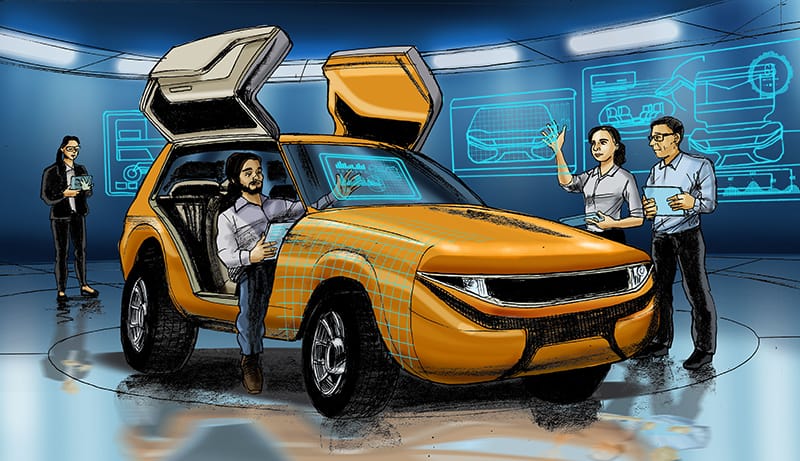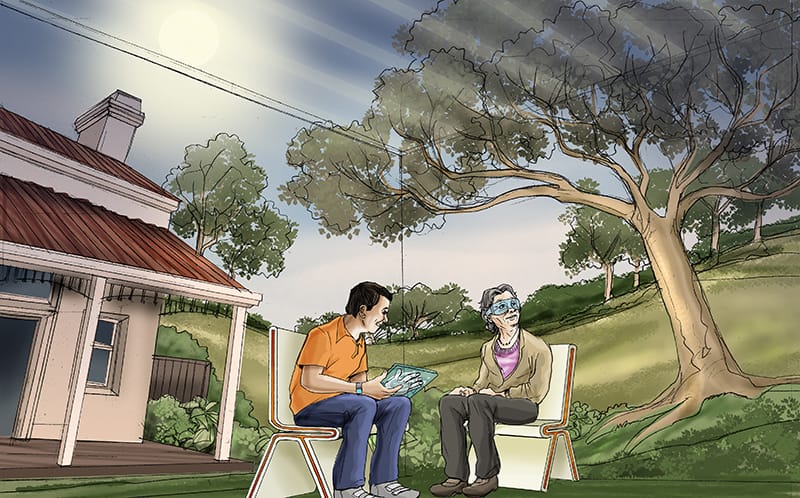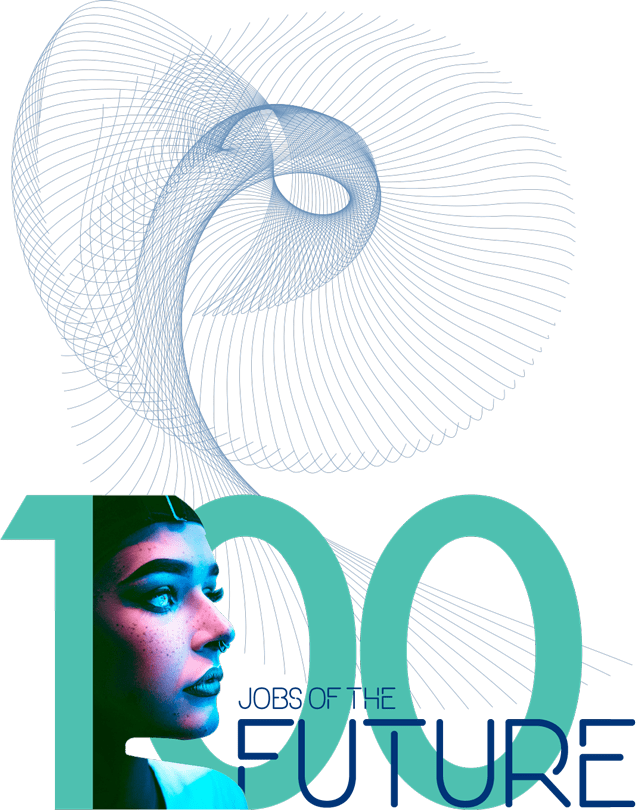Work Futures: Looking Forward
Across the experts there are differences in emphasis that relate to the experts’ varied disciplinary backgrounds and current interests. Nevertheless, a number of strong themes come through in their analysis of trends, possible directions jobs will take, and the skills that will help young people gain these future jobs.
Future trends
Much of the experts’ thinking about the future concerned the impact of technology on our lives and our work — these included: big data and algorithms, 3D printers and prosthetics, intelligent materials, and vastly more nuanced and complex ways of communicating. In this they were almost uniformly optimistic, pointing out the possibilities for better and healthier lives, enhanced communities, and more space opened up in jobs to be more fully human, removing the drudgery that will be taken over by machines. Of course, there was an acknowledgement of the negative possibilities of disruption to lives and to workplaces, but mostly the experts focused on the positives. None of them subscribed to a dystopian vision of the future. Of course, these emphases relate to their positions as professionals looking to the future, and also to the focus of the interviews, on future jobs. Implicit in many of the job changes they describe are job losses.
While all of the experts acknowledged the substantial changes related to technological innovation and widespread access to this, each of them focused on particular discipline areas. There were common themes here too. Some talked about changes due to an aging population, and healthcare more generally, stressing the ways in which jobs in the health sector will be more interesting and successful with better information and technological advances in care. These changes are expected to free up health workers to focus more on the human aspects of their jobs.
With environment jobs related to climate change, much of the discussion was implicit, focusing on new energy processes, intelligent building materials and customised design, low energy production, built in recycling of materials, and the production of lighter, stronger materials that are more energy efficient.
In both e-commerce and entertainment we have the possibility of greater choice and more tailored products that, if managed well, will enrich our lives.
These trends and themes have also been identified in the work futures literature, but the experts provided numerous additional insights, particular within their fields of expertise, about the potential jobs, the benefits technology would provide, and how young people might grapple with the opportunities that will flow from these changes.
Humans and machines
A number of the experts talked explicitly about the relationship of machines to humans and to human needs. In the health sector, and in material science and engineering, it is clear that we will have in the future much more intimate contact with machines. This will be true whether it be intelligent implants (well beyond pacemakers or knee replacements), personal communication devices, or intelligent clothing that monitors and provides advice. David Ramadge talked of the ‘singularity’ where the dividing line between what is human and machine becomes blurred.

A number of the experts saw this humanmachine interface as being a major focus of many future jobs. These jobs will involve translation of computing advances to human applications, and the interpretation of innovative software and hardware for people. In the other direction, jobs are likely to open up for those able to communicate human needs and possibilities to programmers, who may be expert in technical matters but need insight into the possibilities these can provide for individuals and communities.
A number of the experts talked explicitly about the advantage humans will always have over machines, in our ethical judgments and in our understandings of human needs and responses. A number argued that machines will take away the drudgery from many jobs while opening spaces for more human interactions producing more rewarding and varied work. In the future, it is likely machines will perform much more complex tasks, to the point of designing other machines. The key, for individuals, is to find ways of working with machines, and so avoid being replaced by them. This, of course, will not only be a matter left to individuals and their strategies, but also for companies and government to help us manage for our betterment.
Skills for Future Work
The experts had much to say about the types of skills that will be needed to prosper in future work, but also the dispositions people will need to retain future oriented skills. One theme that comes up strongly is the move towards cross-disciplinarity. This took various forms:
- People having deep knowledge of one area supplemented with wider knowledge to support working in cross-disciplinary teams
- People marrying disciplinary knowledge with knowledge of technology in order to understand the meaning of data, and of data needs
- People being able to work across disciplinary ideas, for instance in STEM, and technology, but with a creative orientation: ‘learn how to code, and learn how to paint’.
Another theme was the likely growing importance of human skills; the capacity to understand and communicate with people, so as to be able to work at the technology-human interface. The ability to work effectively in teams will be vital, particularly when working freelance across a range of projects, often concurrently. Having community and citizenship skills will also be important while working with technology applications.

The third strong theme that emerged was the need for flexibility and adaptability in the face of change. Future workers will have many jobs over a lifetime, and people who can adapt, and stay ahead of the needs of the workplace, rather than waiting to be shown, will prosper in this environment. The capacity to learn, and to be strategic about learning, will increasingly become the key to success. In the future, qualifications are predicted to be shorter term, more varied, but also something people will need to continually update through all phases of life. Life-long learning will be universally acknowledged as the only way to retain skills needed in society.
The 100 jobs
The jobs that were created from these interviews are described, and grouped in the next section. They form a varied and fascinating set. Many were explicitly described by the experts, but many also were projections based on what was said about future work trends and the capabilities that people will require to navigate them, in some cases amalgamating the views of a number of interviewees. The jobs cannot therefore be ascribed to individual experts.
Some of the jobs are surprising, providing fresh perspectives on our likely future lives. The job of Nostalgist, in charge of preserving and highlighting productive memories for older people, is one of these. We will have Aestheticians helping us with our appearance, and Cyborg Psychologists helping us come to terms with our synthetic organs. Many jobs have to do with innovative design, such as 3D Printed Building Design, or Fusionists working at the interface of professions. There are jobs that are the result of environmental concerns, such as the Cricket Farmer, or Weather Control Engineer. Many of the jobs exist in some form today but the future job involves its inclusion of technology, or different dynamics caused by social movement. We have tried to make these changes explicit in our descriptions. With each job, we have described the key skills implied.

Together, the jobs give a complex and surprising set of insights into possible futures. They offer a grounded experience of what future work might look like for individuals, and by implication what our future lives might entail, in ways that most work future literature does not provide.
Through this research we believe we have uncovered new lines of thought about work futures. This helps to put flesh on the bones of the future in a way that the public, and particularly young people who need to think themselves into such futures, can relate to. Within the job descriptions there is optimism about possibilities for future human and community lives, but also warnings, for instance, about privacy issues, sustainability challenges and what needs to be in place to tackle these. There are also challenges for how we think of ourselves in relation to ever more complex, personal machines that will increasingly become central to our lives.
Of course, these jobs, while many and varied, do not represent a complete future of jobs, in no way does this represent an exhaustive catalog of all jobs that will be performed in the future. Many jobs, for instance, will change very little, particularly those that involve skilled manual work that machines cannot duplicate. We have not described these. There will be many other jobs that arise from future trends that our experts have not thought of. The 100 jobs we have described, however, provide an authoritative snapshot into future work and future possibilities while offering a glimpse of the skill-sets likely to be rewarded in the future workplace. We base our claim of ‘authoritative’ on the quality of the experts and the positions of insight they hold, across a range of disciplines. We have, with this research, presented a largely optimistic, complex view of the future, that we believe will be useful in bringing to the attention of young people soon to enter the job market, just what the future might hold for them, and what are the interests, values, dispositions and skills that will best prepare them to be productively involved in this future.
Next steps
These expert interviews, and the jobs emerging from them, invite further analysis. We intend to transform them from an item of insight and interest, to a useful tool to help youth in thinking about preparing for the future, and its possibilities for them. We intend to sort the jobs into broad career interest categories, and also more specific future role and task themes. For the career interest categories, we intend to use the well established RIASEC dimensions (Holland, 1996, 1997) that categorise jobs into Realistic, Investigative, Artistic, Social, Enterprising, and Conventional types, and for the specific future role and task themes, we will draw upon the literature review and data generated from the interviews with experts as part of this project. We will create an interactive resource that young people can use to explore their own career interests, and from this to imaginatively project into possible interesting and rewarding work futures.



